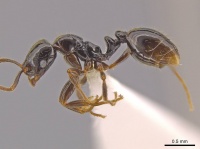Megalomyrmex megadrifti
| Megalomyrmex megadrifti | |
|---|---|
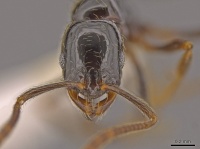
| |
| Scientific classification | |
| Kingdom: | Animalia |
| Phylum: | Arthropoda |
| Class: | Insecta |
| Order: | Hymenoptera |
| Family: | Formicidae |
| Subfamily: | Myrmicinae |
| Tribe: | Solenopsidini |
| Genus: | Megalomyrmex |
| Species group: | pusillus |
| Species: | M. megadrifti |
| Binomial name | |
| Megalomyrmex megadrifti Boudinot, Sumnicht & Adams, 2013 | |
It is likely that this species is a twig or leaf-litter nester, as queens, workers, and males have been collected together in Winkler samples. Along its Central American range, M. megadrifti has been collected almost exclusively via leaf litter sifting. In Nicaragua a male was collected in early May via malaise trap. (Boudinot et al. 2013)
Identification
Boudinot et al. (2013) - Worker uniquely identified among Central American Megalomyrmex by the following character combination: (1) katepisternum smooth and shining; (2) 5–7 small, sharp, subequal teeth subtending large apical 2; (3) propodeum often dentate where dorsal and posterior faces meet; (4) occipital carina not visible in full-face view. Queen similarly identifiable as worker, alate. Male Differs from all Central American Megalomyrmex by the following combination of characters: (1) crossvein 1m-cu present; (2) occipital carina not visible in full-face view; (3) scape about three times longer than pedicel; (4) first gastric tergum with numerous short appressed setae.
Megalomyrmex megadrifti and Megalomyrmex drifti were found in sympatry in Las Marias, Honduras, and P.N. Cerro Saslaya, Nicaragua. We collected the two species in narrow sympatry near Rama, Nicaragua. Megalomyrmex megadrifti was also collected in sympatry with Megalomyrmex brandaoi on the Barva Transect, Costa Rica. Megalomyrmex megadrifti can always be separated from Megalomyrmex drifti, at least for Central American populations, by the quantitative characters of body size (ML), and relative scape (SI) and malar space length (OMI). The new species is considerably larger than M. drifti in all three metrics. No overlap was observed in these traits among all measured individuals, including sympatric and allopatric populations (ML > 0.80 vs. < 0.75; SI > 87 vs. < 85; OMI > 62 vs. < 59).
The most critical qualitative character which separated M. drifti from M. megadrifti is the distinctness of the basal and masticatory mandibular margins for the new species. This character can, however, be tricky to interpret without direct comparison between specimens of both species when M. drifti has basal denticles at midlength of the curve between the margins, or when M. megadrifti lacks a basal denticle at the angle. Beyond mandibular form, other qualitative characters can be useful for distinguishing the two species. Megalomyrmex megadrifti may often be recognized by (1) the presence of small, pointed tubercles where the dorsal and posterior propodeal faces meet, (2) rugulae cover the posteroventral fourth of the katepisternum, (3) median, longitudinal clypeal sulcus shallow, (4) the promesonotum is strongly convex, and (5) when the posterior face of the propodeum has distinct (or indistinct) concentric carinulae around the foraminal carina. A medium-sized, mid-elevation specimen displaying all five of these qualitative characters was chosen as the holotype.
The most notable distinctions between the male of M. megadrifti and Megalomyrmex brandaoi are related to volsellar form. These differences are as follows, from the perspective of M. megadrifti: (1) cuspis with apicoventral angle less produced; (2) base of digitus broader; (3) apicodorsal lobe of digitus broad, distinct from apical portion (vs. narrower and indistinct from apical portion); (4) apical portion of digitus narrow, digitiform.
Keys including this Species
Distribution
Southern Mexico to Costa Rica; South American distribution to be clarified but known from Colombia and Argentina. This species has broad geographic and elevational ranges and occurs in a variety of habitats. In Central America it occurs from Chiapas to Costa Rica, from sea-level to 1520 m, in rainforests and in cloud forests. (Boudinot et al. 2013)
Latitudinal Distribution Pattern
Latitudinal Range: 25.68015° to -25.98333333°.
| North Temperate |
North Subtropical |
Tropical | South Subtropical |
South Temperate |
- Source: AntMaps
Distribution based on Regional Taxon Lists
Neotropical Region: Argentina, Belize, Colombia, Costa Rica, Guatemala, Honduras, Mexico, Nicaragua (type locality).
Distribution based on AntMaps
Distribution based on AntWeb specimens
Check data from AntWeb
Countries Occupied
| Number of countries occupied by this species based on AntWiki Regional Taxon Lists. In general, fewer countries occupied indicates a narrower range, while more countries indicates a more widespread species. |

|
Estimated Abundance
| Relative abundance based on number of AntMaps records per species (this species within the purple bar). Fewer records (to the left) indicates a less abundant/encountered species while more records (to the right) indicates more abundant/encountered species. |

|
Biology
Castes
Worker
Images from AntWeb
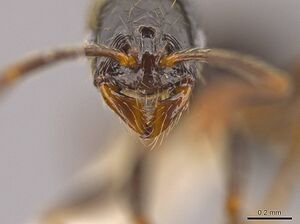 
| |
| Holotype Megalomyrmex megadrifti. Worker. Specimen code casent0630930. Photographer Brendon Boudinot, uploaded by University of Utah. | Owned by MCZ. |
Queen
Images from AntWeb
 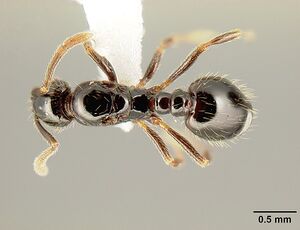  
| |
| Queen (alate/dealate). Specimen code casent0611359. Photographer John T. Longino, uploaded by University of Utah. | Owned by JTLC. |
Male
Images from AntWeb
 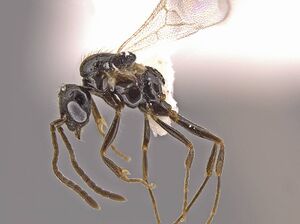 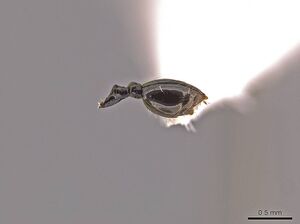  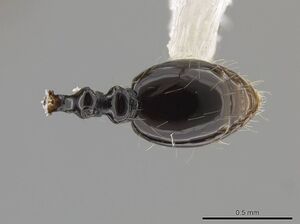 
| |
| Male (alate). Specimen code casent0630906. Photographer Brendon Boudinot, uploaded by University of Utah. | |
Nomenclature
The following information is derived from Barry Bolton's Online Catalogue of the Ants of the World.
- megadrifti. Megalomyrmex megadrifti Boudinot, et al. 2013: 41, figs. 37, 40, 72, 87, 127-130, 182, 197, 212, 227, 239 (w.q.m.) NICARAGUA, ARGENTINA (Formosa), BELIZE, COLOMBIA, COSTA RICA, GUATEMALA, HONDURAS, MEXICO (Chiapas, San Luis Potosi, Tamaulipas, Veracruz).
- Type-material: holotype worker, 1 paratype worker, 1 paratype queen.
- Type-locality: holotype Nicaragua: Jinotega, PN Cerro Saslaya, 12.772°N, 84.9977°W±20 m., 7100 m., 8.v.2011, montane wet forest, sifted leaf litter, LLAMA#Wm-D-02-1-09; paratypes with same data.
- Type-depositories: MCZC (holotype); MCZC, MZSP (paratypes).
- Distribution: Argentina, Belize, Colombia, Costa Rica, Guatemala, Honduras, Mexico, Nicaragua.
Unless otherwise noted the text for the remainder of this section is reported from the publication that includes the original description.
Description
Worker
(holotype): HW 0.56, HL 0.68, SL 0.62, OMD 0.12, EL 0.15, ML 0.92, CI 82, SI 92, EI 27, OMI 76.
Measurements (n=23): HW 0.52–0.63, HL 0.60–0.72, SL 0.55–0.70, OMD 0.10–0.13, EL 0.14–0.18, ML 0.81–0.99, CI 82–89, SI 89–97, EI 25–30, OMI 65–91.
Head Palpal formula 3,2. Basal and masticatory margins of mandible distinct, demarcated by an angle with a small tooth. Mandible with 4–6 teeth; apical tooth largest, almost three times as long as subbasal tooth; subbasal tooth slightly larger than basal teeth; basal teeth subequal, variably placed. Dorsal surface of mandible smooth and shining, interrupted by weak piligerous punctae. Clypeus truncate in profile view. Clypeal carinae present, weak to indistinct; diverging anteriorly. Clypeus between antennal insertions narrower than maximum width of scape. Antennal fossa encircled by 2–4 complete carinulae. Malar area with or without fine carinulae in anterior half; smooth and shining posteriorly. Compound eye with several ocular setae. Compound eye relatively distant from lateral clypeal margin (OMI > 60). Scape relatively long (SI ≥ 89). Occipital carina strong, short; obscured by vertex in full-face view; extending anteroventrally less than one eighth the length of the postgenal bridge. Mesosoma Katepisternum and promesonotum smooth and shining; propodeum smooth and shining, excluding close-set 3–4 metapleural carinulae and concentric carinulae around complete foraminal carina. Metapleural carinulae do not reach meso-metapleural suture. Metanotum deeply and narrowly or broadly incised. Propodeum with dorsal and posterior faces meeting at a blunt to denticulate angle; propodeum not to weakly marginate dorsolaterally; dorsal margin weakly concave to linear in profile view. Meso- and metabasitarsi tubular. MetasomaPetiole and postpetiole predominantly smooth and shining, except for girdling carinulae at posterior bases. Subpetiolar process a weak to strong, short angular flange. Postpetiolar sternum variable: bidentate, with a single process, or with two ridges. Lancets of sting apparatus flattened, narrow, weakly spatulate. Setation Fine; head dorsum with long, somewhat dense subdecumbent to suberect setae and medium appressed setae which are most abundant on gena; setae on scape almost entirely appressed; promesonotum with about 12–14 setae on each lateral half, most setae long; first gastric tergum with somewhat more dilute suberect to subdecumbent setae, in addition to numerous short, appressed setae. Head, meso- and metasoma shining black to light brown; mandibles, antennae and legs dark brown.
Queen
(n=8): HW 0.58–0.65, HL 0.64–0.72, SL 0.57–0.65, OMD 0.09–0.11, EL 0.19–0.21, ML 0.96–1.08, CI 90–94, SI 89–93, OMI 45–53.
Similar to worker, differing mainly in having an alate-condition mesosoma.
Male
(n=2): HW 0.56–0.60, HL 0.55–0.58, SL 0.17, OMD 0.02, EL 0.29–0.31, ML 0.90–0.99, CI 101–104, SI 30–31, EI 51–52.
Head Antenna with 13 antennomeres, antennomeres 6 and 7 weakly curved; not forming a club; scape length much shorter than head length; entire antenna brown, scapes shining black. Palpal formula 3,2. Mandible subfalcate; masticatory margin with 4–5 sharp, somewhat long triangular teeth, decreasing in size from apical tooth. Dorsal surface of mandible weakly roughened, but otherwise smooth and shining. Minimum distance between lateral ocellus and compound eye distinctly greater than three lateral ocellus lengths. Compound eye with few, sparse ocular setae. Occipital obscured by vertex in full-face view. Mesosoma Mesosoma robust. Notauli absent. Parapsidal lines very weakly indicated. Foraminal carina incomplete. Metasternum without a triangular process. Basitarsi tubular. Pterostigma well-developed. Forewing crossvein 1m-cu present; submarginal cell 1 length about twice width; terminal abscissa of M branching from where 2r-rs meets Rs, becoming spectral where M curves apicad. Metasoma Basipetiolar carina parabolic. Ventrolateral longitudinal suture of petiole present. Petiolar spiracle in anterior third. Petiolar and postpetiolar terga with girdling carinae along posterior base. Postpetiolar helcium approximately circular. Postpetiolar spiracle placed about the first third of the lateral tergum margin. Sternum of postpetiole concave in profile view with a very weak anterior bulge. Postpetiolar tergum shallowly but evenly convex, with apex about midlength; not bilobed. Genitalia Abdominal sternum IX lateral margins tapering to apex; apex neither keeled nor with a distinct degree of sclerotization; apical process indistinct. Telomere short, triangular, blunted apically; medial dentiform process absent; medial face of telomere subquadrangular; ventral margin without sclerotized denticles. Cuspis broadly lobate apicodorsally; concave apicomedially. Digitus broad basally, with a broad apicodorsal lobe which is distinct from the thin digitiform apical portion; ventral margin a skewed parabola; ventral margin obscuring apicodorsal portion of cuspis. Valviceps height less than length, somewhat wedge-shaped; dorsal margin meeting ventral margin at a rounded angle apicodorsally; ventral margin unevenly and weakly convex; penisvalvar teeth much shorter than broad, finely pointed.
Type Material
Holotype worker NICARAGUA, Jinotega: P.N. Cerro Saslaya, 12.772°N -84.9977°W ±20 m, 710 m, 8 May 2011, montane wet forest, ex sifted leaf litter (LLAMA#Wm-D-02-1-09) [CASENT0630930, Museum of Comparative Zoology]. Paratype worker: (1) same data as holotype [CASENT0630931, Museu de Zoologia da Universidade de Sao Paulo]. Paratype queen: (1) same data as holotype [CASENT0630932, MCZ].
Etymology
The specific epithet refers to the size of this new species relative to the very similar Megalomyrmex drifti. The epithet is a noun in apposition and thus invariant.
References
References based on Global Ant Biodiversity Informatics
- Boudinot B. E., T. P. Sumnicht, and R. M. M. Adams. 2013. Central American ants of the genus Megalomyrmex Forel (Hymenoptera: Formicidae): six new species and keys to workers and males. Zootaxa 3732(1): 1-82.
- Dattilo W. et al. 2019. MEXICO ANTS: incidence and abundance along the Nearctic-Neotropical interface. Ecology https://doi.org/10.1002/ecy.2944
- Longino J. T. L., and M. G. Branstetter. 2018. The truncated bell: an enigmatic but pervasive elevational diversity pattern in Middle American ants. Ecography 41: 1-12.
- Longino J. et al. ADMAC project. Accessed on March 24th 2017 at https://sites.google.com/site/admacsite/
